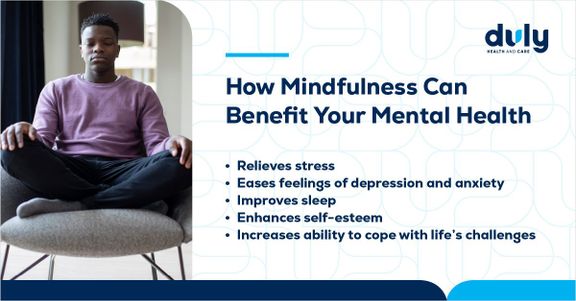The feeling of your lungs inhaling and exhaling, the sound of a clicking keyboard, the texture of the soft carpet on your feet — you probably experience sensations like these every day.
And yet, when is the last time you stopped to notice these small, but meaningful, moments?
If you’re like many, you go about your day without stopping to notice the details about how your body feels and what’s going on around you. But paying attention to these details can actually benefit your mental health.
This is called mindfulness, or the practice of being fully aware of what’s happening in the moment inside your body and within your surroundings, then accepting them without judgment. Mindfulness has been shown to improve your mental health by reducing stress, which more than half of American adults report experiencing every day. It can also ease anxiety and depression, among other mental health benefits.

May is Mental Health Awareness month — a time to focus on improving your mental well-being. One way to do this is by building mindfulness into your life. Here are 5 ways to incorporate mindfulness into your daily routine.
1. Notice your breathing.
Unless you’ve just finished a tough workout or are recovering from a cold, you probably don’t notice your breathing most days. You take about 20,000 breaths every day — each of which is an opportunity to pause and practice mindful breathing.
Mindful deep breathing is paying attention to the sensation of the breath coming in and out of the body, noticing the breath, how and where you feel it in the body without trying to change it.
To practice mindful deep breathing:
- Sit or lie down in a calm location.
- Close your eyes, and place one hand on your stomach and the other on your chest.
- Slowly take a deep breath in through your nose — and hold it for a few seconds.
- Slowly exhale the breath through your mouth.
- Repeat this cycle, noticing how your hands move with each breath and how your body reacts.
- Continue for about five to ten minutes or until you are deeply relaxed.
2. Do a “body scan” each day.
There are a lot of sensations going on in your body at any given moment. From an itch on your leg to the way your heart is beating, all of these feelings can bring awareness to your body. By mentally scanning yourself, you bring awareness to every single part of your body, noticing any aches, pains, tension, or general discomfort.
To deeply notice what’s going on in your body, do a body scan each day. Take the time to notice the feelings in your body from your head to your toes. Pay attention to small sensations, like an itch or tingling. Don’t view these feelings as good or bad. Instead, simply notice them as a part of your body.
3. Practice mindful eating.
Multiple times a day, you feed your body with nutritious food and drink. But when is the last time you really paid attention to the tastes, textures, and sensations during mealtime?
Mindful eating is an approach to food that focuses on your sensual awareness of the food you eat and your experience of the food.
Incorporating mindful eating practices has been shown to have benefits for individuals including:
- A renewed sense of hunger and fullness.
- Weight loss management and maintenance.
- Improved self-esteem.
- A sense of empowerment
Begin by noticing true hunger cues. Instead of eating when you’re “supposed to” or when you feel bored or stressed, eat when your body is telling you it’s hungry. One trick is to ask yourself if you would eat an apple (or another healthy food). If not — but you’re reaching for a bag of chips — you might not truly be hungry.
When you decide it’s time to eat:
- Sit at a table — not in front of the television or at your desk while working; minimize distractions.
- Slowly take small bites.
- Pay attention to every aspect of your food, including its taste, texture, smell, and appearance.
4. Try mindful meditation.
Meditation has long been a way to quiet the mind and reduce stress. By adding a mindful twist, you can benefit even more from this practice.
Mindful meditation has two parts — attention and acceptance. It begins by focusing on what’s happening in the moment, including your breath, thoughts, and physical sensations. It continues with accepting these thoughts and feelings without judgment. Instead, you note their existence and then let them float away.
While you can practice mindful meditation on your own by sitting quietly and paying attention to your thoughts and physical feelings, you may benefit from support from an outside source, such as a meditation app or a session with a behavioral health specialist. Once you get the hang of mindful meditation, you can practice it anytime, anywhere.
5. Pay attention to the world around you.
As you go about your day, there’s a flurry of activity going on around you. From the sound of cars driving by to the smell of fresh spring air, these sensations are worth taking the time to notice.
You can practice mindfulness at any moment of the day by pausing to pay attention to the world you live in. Note these sights, smells, sounds, tastes, and touches without judgment. Acknowledge them as they are and how they make you feel. Then, release them.
Mindfulness as a Part of Your Daily Routine
Mindfulness is not a one-time practice. Rather, it’s a way of living you can build into nearly every aspect of your life. From your morning routine to your meals to every moment in between, you can be mindful of what’s going on around you and how it’s impacting you.
In turn, mindfulness can help you feel engaged in your day-to-day life and give a much-needed boost to your overall well-being. Many people who practice mindfulness report an increased ability to relax, a greater enthusiasm for life and improved self-esteem.
Health Topics:








